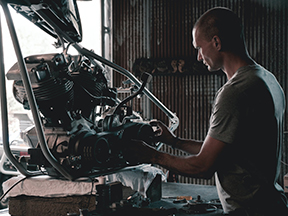7 Avoidable Mistakes When Doing an Engine Rebuild
10/23/2022

Rebuilding an engine in Dallas is an exciting but challenging endeavor. There is little margin for error due to the precision work required. A lot can go wrong when doing a rebuild, from misalignments to misfires, blown gaskets, and engine seizures, to name a few. Even the tiniest of mistakes can lead to hours/days of extra work, elevated costs, and even catastrophic failure.
While it's highly recommended you hire a renowned auto repair shop with certified technicians and better tools and equipment, there's nothing wrong with taking the DIY route as long as you play it safe and learn as much as possible before taking on this project.
In this post, we'll share seven mistakes to avoid when doing an engine rebuild to save time, money, and headaches. So, let's get right into it.
7 Mistakes to Avoid When Doing an Engine Rebuild
- Improper Measurements
Taking exact measurements is a fundamental aspect of rebuilding an engine since the core of the project lies in small details. You have to check a multitude of components, including cylinders, crankshafts, valves, pistons, bearing clearings, etc., and keep an eye out for defects and cracks.
To measure engine components, you're going to need tools like micrometers (outside, inside, depth, etc.), gauges, dial indicators, and vernier calipers, to name a few. By doing this, you'll learn more about what's under your hood and double-check the results of your rebuild to minimize mistakes and prevent damage.
- An Unclean and Cluttered Workspace
If you've ever been to a modern auto repair shop, you will notice how organized the workspace is. Experienced technicians understand the value of a decluttered workspace with tools, components, bits, and fluids all organized strategically. Doing so helps them save time and provides a safer working environment.
So, before starting your engine rebuild, make sure you have everything you need front and center and the remaining tools and components in special storage. We recommend using toolboxes, rolling carts, and hangers, among other storage options. As for the fluids, try to keep them in low-traffic areas to avoid spillage.
- Not Making a Disassembly Video
The last thing you want to experience is finding a few extra nuts, washers, bolts, or other components after you're reassembled your engine. This can lead to time wastage and unnecessary frustration. Due to the complexity of modern engines, it's easy to miss something.
In the digital age, you can find hundreds of videos and tutorials you can use to make things easier when rebuilding an engine. However, you can go step one further by breaking out your smartphone to record every step of the engine disassembly.
Along with helping you remember all the crucial steps and elements, it also serves as a great reminder of your efforts. You can post it on social media or YouTube to show the world.
- Unnecessary Urgency
Rebuilding an engine requires a tremendous amount of patience. Therefore, the last thing wants to do is rush things to get it over with. You need to take your time and double-check everything, especially when assembling the different components back together.
Unnecessary urgency could lead to time wastage, mistakes, or extra expense, especially when inserting the crankshaft into the crankcase, timing the engine, or reassembling the pistons and cylinders.
- DIY Machining
DIY machining is one of the biggest mistakes most car enthusiasts make when rebuilding their engines on their own. Machining is an essential process in any rebuild, and you must spare no expense in this regard.
By opting for a professional machine shop, you hire experienced professionals with the proper tools and solutions to undertake this complex task. At the very least, you should consider consulting professionals for tips and advice if you're keen on pursuing the DIY route.
- Using Old fasteners
While many engine components can be salvaged and reused in your rebuild, the last thing you want to do is use old fasteners (head bolts, washers, nuts, etc.) to secure your components. Over the years, these components get worn out due to stress and other forces. Therefore, replacing the critical ones is essential for ensuring stability and minimizing vibrations.
- Improper Cleaning
The purpose of an engine rebuild is to maintain, upgrade, or optimize performance. However, one crucial mistake many amateurs make is not cleaning the parts they intend to reuse during the reassembly. Yes, the process can be time-consuming and feel redundant, considering it's going to get dirty again over time.
However, apart from improving your engine's aesthetic appeal, washing and cleaning old components will help you identify signs of wear, scratches, and cracks so you can replace them proactively. Moreover, cleaning old components (especially those with rust) will help protect new ones from premature wear out and damage.
Hire K3S Auto Repair for Your Engine Rebuild
K3S Auto Repair is an award-winning, family-owned auto repair shop in Dallas, Texas. Since our founding, our team of certified technicians has used the latest tools to help hundreds of clients get premium-quality automotive services.
We're equipped with the latest tools, parts, and technologies in the market, so you can rest assured we've got everything you need to ensure optimal performance.
So, whether you are looking for quick service, repairs, or an engine rebuild, we've got you covered. Feel free to schedule an appointment or request a price quote. You can also call us at our Dallas shop at (817) 934-6192.

